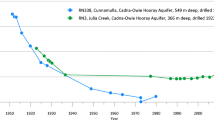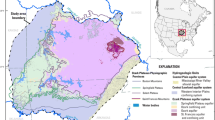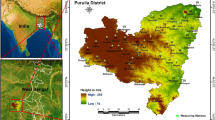Abstract
Time-series and current estimates of groundwater use are critical for conceptualisation of groundwater systems and for understanding system responses. A key challenge for managing Australia’s Great Artesian Basin (GAB) is the limited available data on water use. In the absence of an existing method, the Queensland Government’s Office of Groundwater Impact Assessment developed a demand-based method to estimate unmetered stock and domestic (S&D) groundwater use in 2016, with further enhancements since then. The method integrates publicly available datasets including property grazing potential and availability of other water supplies to derive a range of groundwater use estimates. The method also distributes the estimated demand for groundwater use across water supply bores and across screened geological formations based on bore construction and screened-aquifer information. The method has been applied to the GAB’s Surat and southern Bowen basins. Integrating the results and outcomes from related research projects, this article provides an overview of the demand-based method, highlighting new understanding of the temporal and spatial distribution of groundwater use. Results were validated at the bore scale with limited metered bore data, and at the sub-regional level from census data and landholder survey information. Across the Surat Basin, comparisons with previous estimates show, as estimated, a reduction in S&D water extraction from approximately 80,000 to 25,000 ML/year.
Résumé
Les séries chronologiques et les estimations actuelles des volumes d’eaux souterraines utilisés sont essentielles à la conceptualisation des systèmes d’eau souterraine et à la compréhension des réponses des systèmes. Un défi clef pour la gestion du Grand Bassin Artésien d’Australie (GBA) est le nombre limité de données disponibles concernant les usages privés de l’eau. En l’absence d’une méthode, le Bureau d’évaluation de l’impact sur les eaux souterraines du gouvernement du Queensland a mis au point une méthode fondée sur la demande pour estimer l’utilisation des volumes non mesurés et des eaux souterraines pour un usage domestique (V&D) en 2016, avec d’autres améliorations depuis lors. La méthode intègre des ensembles de données accessibles au public, y compris les surfaces potentielles de pâturage des propriétés et la disponibilité d’autres réserves d’eau afin d’en déduire une gamme d’estimations de l’utilisation des eaux souterraines. La méthode répartit également la demande d’utilisation des eaux souterraines entre les forages existants et les formations géologiques interceptées à partir de l’information concernant des forages réalisés et des niveaux aquifères crépinés. La méthode a été appliquée aux bassins de Surat et du Sud de Bowen du GBA. Intégrant les résultats et conclusions de projets de recherche connexes, cet article donne un aperçu de la méthode fondée sur la demande, mettant en évidence une nouvelle compréhension de la répartition temporelle et spatiale de l’utilisation des eaux souterraines. Les résultats ont été validés au niveau de forage avec des données limitées sur les forages mesurés, et au niveau sous-régional à partir des données du recensement et de l’information sur l’enquête des exploitants fonciers. Dans l’ensemble du bassin de Surat, les comparaisons avec les estimations précédentes montrent, comme prévu, une réduction de prélèvement de l’eau de V&D d’environ 80,000 à 25,000 ML/an.
Resumen
Las series temporales y las estimaciones actuales del uso de las aguas subterráneas son fundamentales para la conceptualización de los sistemas de aguas subterráneas y para comprender las respuestas del sistema. Un desafío clave para la gestión de la Great Artesian Basin en Australia (GAB) es la escasez de datos disponibles sobre el uso privado del agua. En ausencia de un método existente, la the Queensland Government’s Office of Groundwater Impact Assessment desarrolló un método basado en la demanda para estimar el uso no medido de los suministros y uso doméstico del agua subterránea (S&D) en 2016, con nuevas mejoras desde entonces. El método integra conjuntos de datos disponibles públicamente, incluyendo el potencial de pastoreo de las propiedades y la disponibilidad de otros suministros de agua para derivar una serie de estimaciones del uso de aguas subterráneas. El método también distribuye la demanda de uso de agua subterránea a través de perforaciones existentes y a través de formaciones geológicas en base a la construcción de perforaciones y a la información de los filtros en los acuíferos. El método se ha aplicado a las cuencas Surat y Bowen meridional del GAB. Integrando los resultados de los proyectos de investigación relacionados, este documento proporciona una visión general del método basado en la demanda, destacando la nueva comprensión de la distribución temporal y espacial del uso del agua subterránea. Los resultados fueron validados a nivel de perforaciones con datos limitados de perforaciones medidas, y a nivel subregional a partir de los datos del censo y de la información de los estudios de los propietarios de las tierras. A lo largo de la cuenca del Surat, las comparaciones con estimaciones anteriores muestran, según lo estimado, una reducción en la extracción de agua del S&D de aproximadamente 80,000 a 25,000 ML/año.
摘要
地下水利用的时间序列和现行估算对于地下水系统概化和弄清系统响应至关重要。管理澳大利亚大自流盆地(GAB)的主要问题是私人生活用水的可用数据有限。由于没有可直接利用的方法,昆士兰州政府的地下水影响评估办公室开发了基于需求的估算2016年未计量储量和生活地下水用量(S&D)的方法,此后该方法可进一步增强。该方法整合了包括放牧潜力和其他供水的可用性的公共可用数据集,以估算地下水利用范围。该方法还基于钻孔结构和滤管所在含水层结构对应的现有钻孔和滤管地质构造来分配对地下水的需求。该方法已被应用于GAB的Surat盆地和Bowen盆地南部。结合相关研究项目的成果和评价结果,本文概述了基于需求的方法,强调了对地下水利用时空分布的新认识。结果是在有限的计量钻孔数据的钻孔级别上以及在普查数据和土地所有者调查信息的子区域级别上进行了验证。在整个Surat盆地,与先前估计的比较发现,经估计的S&D抽水量从80,000L减少到25,000 ML/year。
Resumo
As séries temporais e estimativas atualizadas do uso das águas subterrâneas são críticos para a conceituação dos sistemas de águas subterrâneas e para a compreensão das respostas do sistema. Um dos principais desafios para o gerenciamento da Grande Bacia Artesiana (GBA), na Austrália, são os dados limitados disponíveis sobre o uso privado da água. Na ausência de um método consolidado, o Escritório de Avaliação de Impacto das Águas Subterrâneas do Governo de Queensland desenvolveu um método baseado na demanda para estimar o uso ilimitado do estoque e do uso doméstico das águas subterrâneas (E&D) em 2016, com melhorias contínuas desde então. O método agrega conjuntos de dados públicos, como o potencial de pastoreio das propriedades e a disponibilidade de outros suprimentos de água para ramificar uma variedade de estimativas de uso das águas subterrâneas. O método também distribui a demanda pelo uso das águas subterrâneas nos poços existentes e nas formações geológicas exibidas com base na construção desses poços e nas informações exibidas no aquífero. O método foi aplicado às bacias Surat e Bowen austral, na GBA. Agregando os resultados de projetos de pesquisa relacionados, este artigo fornece uma visão geral do método, baseado na demanda, destacando uma nova compreensão da distribuição temporal e espacial do uso das águas subterrâneas. Os resultados foram validados no nível do poço, com dados limitados de medições de poços, e no nível subregional a partir de dados do censo e informações de pesquisa com proprietários rurais. Em toda a bacia Surat, comparações com estimativas anteriores mostram, como estimado, uma redução na extração de água de E&D de aproximadamente 80,000 para 25,000 ML/ano.








Similar content being viewed by others
References
ABS (2012) Agricultural commodities, Australia, 2010–2011. Australian Bureau of Statistics, Canberra
Banks E, Wilson T, Green G, Love AJ (2007) Groundwater recharge investigations in the Eastern Mount Lofty Ranges, South Australia. DWLBC report 2007/20. DWLBC, Adelaide, Australia
Burton JR (1965) Water storage on the farm: a manual of design, construction and operation for Australian conditions. Water Research Foundation of Australia, Sydney
Costa JL, Gomide JA (1991) Drying rates of tropical grasses. Trop Grasslands 25:325–332
Craig IP (2005) Loss of storage water due to evaporation - a literature review. Technical Report. University of Southern Queensland, National Centre for Engineering in Agriculture, Toowoomba, Australia
CSIRO (1974) Lands of the Balonne-Maranoa Area, Queensland. Commonwealth Scientific and Industrial Research Organisation, Melbourne
Department of Natural Resources Mines and Energy Queensland Government (2018) Dams and weirs: Queensland. Licensed under Creative Commons Attribution 4.0. DNRME, Brisbane, Australia
Dieter CA, Maupin MA, Caldwell RR, Harris MA, Ivahnenko TI, Lovelace JK, Barber NL, Linsey KS (2018) Estimated use of water in the United States in 2015. US Geol Surv Circ 1441
Habermehl MA (2019) Review: The evolving understanding of the Great Artesian Basin (Australia), from discovery to current hydrogeological interpretations. Hydrogeol J. https://doi.org/10.1007/s10040-019-02036-6
Keir G, Bulovic N, Mcintyre N (2019) Stochastic modeling of groundwater extractions over a data-sparse region of Australia. Groundwater 57:97–109. https://doi.org/10.1111/gwat.12658
Klohn Crippen Berger (2016) Hydrogeological assessment of the Great Artesian Basin: characterisation of aquifer groups—Eromanga Basin. Report prepared July 2016 for Department of Natural Resources and Mines, Brisbane, Australia
Larsen C, Wallis D, Toulmin M, Gaskill S (2014) The importance of estimating stock and domestic water use in the context of a water constrained future: lessons from the Woori Yallock Catchment, Victoria Australia. Australas J Water Resour 18:191–204. https://doi.org/10.1080/13241583.2014.11465450
Lovelace JK (2009) Methods for estimating water withdrawals for livestock in the United States. US Geol Surv Sci Invest Rep 2009–5041, 7 pp
MLA (2013) Pasture utilisation. Meat and Livestock Australia, Queensland. http://mbfp.mla.com.au/Pasture-utilisation/. Accessed 10 November 2017
MLA (2006) Beef cattle nutrition: an introduction to the essentials. Meat and Livestock Australia, Bowen Hills, QLD, Australia
National Water Commission, Sinclair Knight Merz, Bureau of Rural Sciences (2010) Surface and/or groundwater interception activities: initial estimates. National Water Commission, Canberra
Newman C, Howitt R, Macewan D (2018) How are western water districts managing groundwater basins? Cal Agric 72:28–37
NSW DPI (2007) Water requirements for sheep and cattle. Primefacts 326. Department of Primary Industries, New South Wales, Sydney
NSW DPI (2006) Pasture assessment and livestock production. Primefacts 323. Department of Primary Industries, New South Wales, Sydney
NSW DPI (2016) How much water do I need for my rural property. Department of Primary Industires, New South Wales Department of Trade and Investment, Regional Infrastructure and Services, Sydney. http://www.water.nsw.gov.au/__data/assets/pdf_file/0005/547061/how-much-water-do-I-need-for-my-rural-property.pdf. Accessed 10 November 2017
O’Keefe V, Webb L, Woolley D, Punthakey JF (2011) Defining the significance of stock and domestic groundwater use in Australia. National Water Commission, Canberra
OGIA (2016) Hydrogeological Conceptualisation Report for the Surat Cumulative Management Area. OGIA, Department of Natural Resources and Mines, Brisbane, Australia
OGIA (2019a) Underground water impact report for the Surat Cumulative Management Area. Department of Natural Resources and Mines, Brisbane, Australia
OGIA (2019b) Updated Geology and Geological Model for the Surat Cumulative Management Area. Department of Natural Resources and Mines, Brisbane, Australia
Parsons Brinkerhoff (2011) Queensland Murray-Darling Basin: methodology for estimating the take of groundwater for stock and domestic purposes. Parsons Brinkerhoff, New York
Phelps D, Broad K, Cowley R, Emery T (2014) Climate savvy grazing (Developing improved grazing and related practices to assist beef production enterprises across northern Australia to adapt to a changing and more variable climate). Meat and Livestock Australia, North Sydney, Australia
Post DA, Chiew FHS, Teng J, Viney NR, Ling FLN, Harrington G, Crosbie RS, Graham B, Marvanek S, McLoughlin R (2012) A robust methodology for conducting large-scale assessments of current and future water availability and use: a case study in Tasmania, Australia. J Hydrol 412–413:233–245. https://doi.org/10.1016/j.jhydrol.2011.02.011
Queensland Department of Environment and Resource Management (2011) Managing grazing lands in Queensland. Queensland Department of Environment and Resource Management. https://www.qld.gov.au/dsiti/assets/soil/managing-grazing-lands-in-qld.pdf. Accessed 10 November 2017
Queensland Department of Primary Industries (1996) WaterNotes collection: a compilation of notes on water supply conservation, use and maintenance for wet and dry times. Department of Primary Industries, Brisbane, Australia
QWC (2012) Underground water impact report for the Surat Cumulative Management Area. Queensland Water Commission, Brisbane, Australia. https://www.dnrm.qld.gov.au/__data/assets/pdf_file/0016/31327/underground-water-impact-report.pdf. Accessed 15 October 2018
Sneath R (2016) Dry season pasture budget: a guide for stocking rates. https://futurebeef.com.au/knowledge-centre/grazing-land-management/dry-season-pasture-budget%2D%2Da-guide-for-stocking-rates. Accessed 10 November 2017
Acknowledgements
The authors acknowledge the initial contribution of Randall Cox (then General Manager, OGIA) for providing strategic direction to conduct this study, and the broader technical team at OGIA for supporting the ongoing development of the methodology. The authors also acknowledge the University of Queensland’s - Centre for Natural Gas - Greg Keir, Neil McIntyre and Nevenkaa Bulovic for sharing metering data to support validation of the method. The authors are grateful to the editors and reviewers whose comments and suggestions significantly improved early manuscripts. Finally, the authors are grateful for the support of Moya Tomlinson in the preparation and editing of the final manuscript.
Author information
Authors and Affiliations
Corresponding author
Additional information
Published in the special issue “Advances in hydrogeologic understanding of Australia’s Great Artesian Basin”
Rights and permissions
About this article
Cite this article
Singh, D., Flook, S., Pandey, S. et al. Improved characterisation of unmetered stock and domestic groundwater use in the Surat and Southern Bowen basins of the Great Artesian Basin (Australia). Hydrogeol J 28, 413–426 (2020). https://doi.org/10.1007/s10040-019-02061-5
Received:
Accepted:
Published:
Issue Date:
DOI: https://doi.org/10.1007/s10040-019-02061-5




